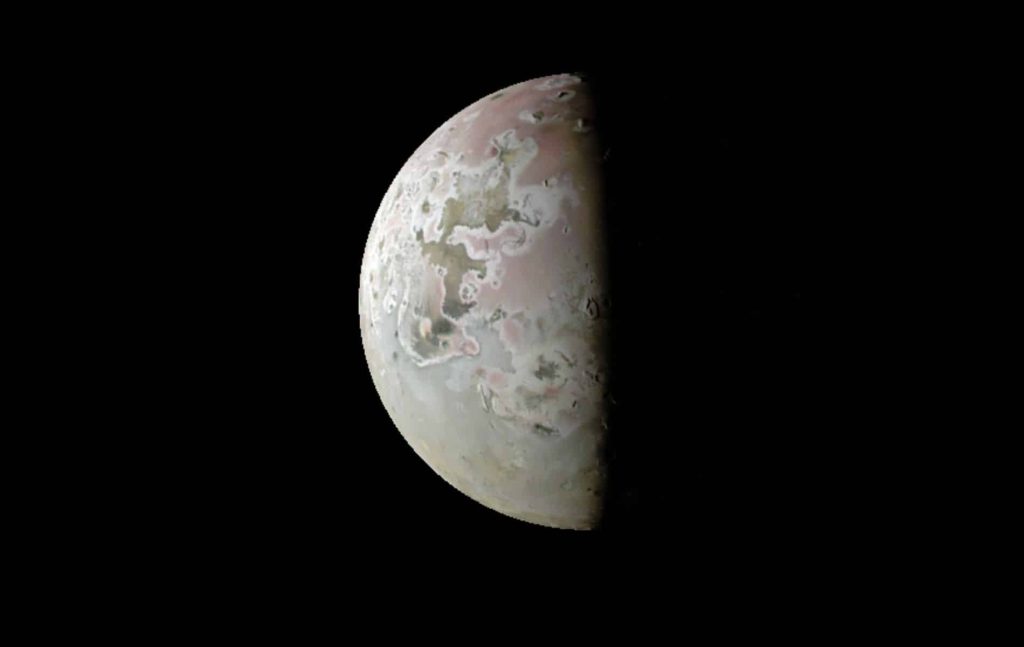NASA’s Juno mission has captured impressive new images of Jupiter’s moon Io, showing its lava-filled surface. These images will allow scientists to conduct in-depth research for years to come.
JunoCam, aboard NASA’s Juno spacecraft, has often spoiled us with plenty of beautiful images of the largest planet in our solar system in recent years. Now the probe has turned its eyes to Jupiter’s volcanic moon Io. The pictures are really amazing, judge for yourself!
Flight
On October 15, 2023, NASA’s Juno spacecraft flew “by” Jupiter’s volcanic moon Io. During his flight, he was able to take beautiful pictures. The closest image, which is the first image in the second row, was taken just 7,000 miles (11,680 kilometers) away.
Technical Specifications
The 15 brand new photos can be admired above. Each image has been meticulously edited using specific points and de An integrated program for imaging devices and spectrometers (ISIS) from the US Geological Survey. The images were then converted to raster perspective projection, resulting in minimal image distortion compared to the original close-up images. The scale ranges from 29.6 kilometers to 7.9 kilometers per pixel, meaning that each pixel in the image corresponds to a specific distance on Io’s surface.
The best photos in two decades
The images sent by Juno are razor-sharp and show Io’s monument-filled landscape in great detail. Therefore, the new images are considered “the best images obtained from Io in 22 years.” This suggests that it is significantly more detailed and at a higher resolution than we have seen in the past two decades, since the Galileo spacecraft last approached the Moon. This improved resolution is of great importance for scientific research and understanding of Io’s surface and geological activities. The new images thus provide scientists with enough material to conduct large-scale research in the coming years.
What is there to see?
The images cover the so-called “anti-Jovian hemisphere” (the part of the Moon on the opposite side of Jupiter). The images also capture the North Pole region of the Moon and the sub-Jupiter hemisphere (the part of Io that is below or toward Jupiter).
North Pole
Newly created images reveal new information about Io’s arctic region, which is dotted with mountains not formed by volcanoes. Some of them reach an altitude of 6000 metres. Unlike other parts of Io, where mountains and volcanoes often come together, relatively few volcanoes can be seen in this area. What is striking is that the regions imaged appear to be quite stable over the past 16 to 22 years (when Io was last imaged by Galileo and New Horizons). Some previous changes have been observed in areas such as Volund, Chorus Patera, and the lava flow east of Gero Patera. But the most noticeable change is the large flow field that has developed at the southern end of Sirte. In short, the new images provide scientists with more information about the Moon’s dynamics and evolution, and contribute to a deeper understanding of Io’s geology and activities.
Mon io pizza
Jupiter has an impressive collection of 79 moons. One of these moons is Io, the innermost of Jupiter’s four large moons. It has a diameter of about 3,642 kilometers, making it slightly larger than our Moon. Io was first seen by Galileo Galilei on January 8, 1610, and was named after the legendary daughter of the river god Inachus. Io is famous for its jagged, perforated surface, leading to its nickname, the “Pizza Moon.” What makes the Moon even more amazing is that it is the most volcanically active celestial body in our solar system. It is also the hottest place in our solar system after Venus and the Sun. Jupiter is partly responsible for volcanic activity. The gas giant’s immense gravity exerts a constant pull, generating friction and heat inside the moon. The intense heat process causes volcanic eruptions repeatedly, spewing sulfur into space. This amazing phenomenon can happen at any time, making Io one of the most dynamic and interesting objects in our solar system.
By the way, we can count on more pictures. Because at the end of 2023 and the beginning of 2024, Juno will once again fly by Io to take a look at the Moon. Observations of Jupiter’s moons are very interesting, although this was not initially part of the Juno mission. The spacecraft’s original purpose was to conduct detailed research on Jupiter itself. However, in early 2021, NASA decided to expand the scope of the mission. So, Juno was tasked with studying not only Jupiter, but also three of its moons — Europa, Io and Ganymede — as well as the rings surrounding the gas giant.
Juno has until at least September 2025 to achieve its extended mission goals, which is remarkable for a spacecraft that was supposed to retire early in 2018. The funny thing is that Juno’s survival is partly due to an unexpected setback. Initially, NASA wanted to place Juno in a fairly close orbit around Jupiter, but this proved difficult to achieve. Instead, the probe remained in a wider, elliptical orbit, which was actually meant to be temporary after arriving at Jupiter. However, this setback turned out to have advantages. Juno was exposed to significantly less harmful radiation in this orbit, which extended the probe’s life. “We found that the radiation environment around Jupiter in this orbit is much less extreme than expected,” lead researcher Scott Bolton noted in 2018, when the mission was extended until summer 2021. This was beneficial not only for the spacecraft, but also for instruments and data quality. That’s why a second extension has been made in 2021. This means we can continue to enjoy beautiful images and new insights, whether about Jupiter itself or some of its more magnificent moons.

“Coffee buff. Twitter fanatic. Tv practitioner. Social media advocate. Pop culture ninja.”







More Stories
Dutch IT Channel – IT systems will provide ‘tax authorities’ with more room for changes from 2027′
Scientists are mixing bacteria with plastic to create a 'living plastic' that appears to have remarkably good properties
Moroccan Asma Boujibar receives $300,000 from NASA